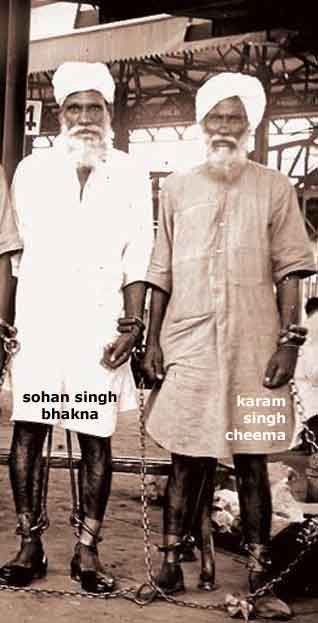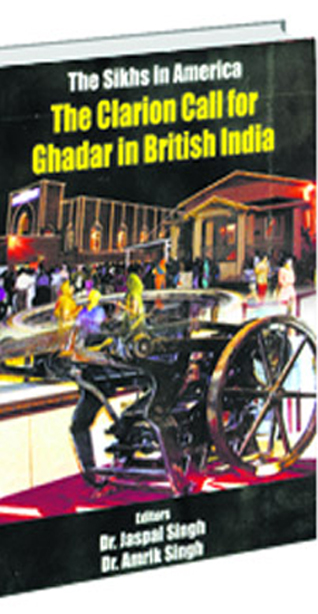Books
The Sikh Freedom-Fighters of North America:
The Ghadar Warriors
Book Review by BHUPINDER SINGH BRAR
THE SIKHS IN AMERICA: THE CLARION CALL FOR GHADAR IN BRITISH INDIA, Edited by Jaspal Singh and Amrik Singh, Sikh American Research Centre, Pacific Coast Khalsa Diwan Society, Stockton, California, USA, pp. xlvii+448. US $ 25.
Centenaries are to countries and communities what anniversaries are to individuals: occasions to foreground and genuinely relive passing major milestones in life journeys, or to remember them just ritualistically.
Only, the scales vary. Individuals gather family and close friends to share the moment; countries and communities raise monuments, or hold seminars and conferences, and publish volumes.
Then, there is another, perhaps more significant, difference.
The way individuals remember their past is filtered by the psychological dynamics of remembering and forgetting. It may even get erased in part simply by the fickleness of human memory. However, countries and communities seem to select and filter their collective memory also through the dynamics of power and hegemonic ideas.
These thoughts occur to me as I read a volume of essays edited by Jaspal Singh and Amrik Singh on the role the Sikhs settled in America played in the Ghadar movement against British colonial rule in India.
The Ghadar Party was formed in 1913 in the US, and in 1915 its members came to Punjab to organise a revolutionary uprising against the British rule. The attempt failed, and led most of leaders to the gallows or incarceration for life in exile.
This tragic turn of events is remembered in the folk memory of Punjab as a saga of great heroes who met their end in the glorious tradition of courage, bravery and sacrifice. In the larger pan-Indian consciousness, this is intentionally downplayed as an episode in the larger militant revolutionary nationalism, a stream that ran parallel to the one projected as constituting moderate and peaceful methods, adopted by the struggle for freedom under the leadership of Mohandas Gandhi.
While the two streams ran parallel to each other, the history-writing of Independence came to be dominated by authors which showed a proclivity towards the stream led by Mohandas Gandhi. In the process, they often portrayed the revolutionaries as impassioned souls driven by romantic love for the country but ending up as actors of marginal importance in the final outcome.
Critics and many historians have alleged that this wasn't an accidental proclivity, that it reflected the way power came to captured and patronage distributed in free India.
Marginalisation of revolutionaries was a necessity for the establishment of a Congress-dominant system, and for pre-eminence of Gandhi-Nehru dynastic politics within it.
Be that as it may, from a pan-Indian perspective of those who would want the importance of revolutionary nationalism to be given its due in history writing, the fate meted out to the Ghadar movement was one more example of a larger malaise, and not an isolated or exceptional case.
To many others who approach this from a more restricted perspective, the marginalisation of the Ghadar movement in Indian historiography leads to a different set of questions and convictions.
Was the movement ignored because it was predominantly Punjabi, and because Sikhs were an overwhelming number among these Punjabis?
Many of the authors point to the majoritarian proclivity to sideline the patriotism of minorities for their homeland, even though the latter contribution was by far the larger, more effective and significant one. They build the case that the movement was inspired by Sikh religious thought and traditions, and in a sense, their not getting their due in history is intimately linked to the discriminatory treatment later meted out to minorities in free India.
As evidence, they present those who try to fudge facts by creatively elevating non-Sikhs among the leaders or followers, or those who try to give a materialist, often Marxist, interpretation of the movement.
On the other side are those who acknowledge that the overwhelming majority in the Gadhar movement were indeed Punjabi Sikhs, but this was only one factor in their self-identification. The argument is that, even as such, they were a subset of a larger sociological group: poor peasants as migrants facing racial discrimination and humiliation.
Based on papers presented in two conferences held in the United States, the merit of this book is that it seeks to give fair representation to the two points of view.
The problem, however, is that the two editors have visibly divergent views on the matter, and hence they did not, or could not, lend an overarching perspective encompassing the two viewpoints even while transcending them.
The truth of the matter is that any movement, which represents nationalist consciousness, has in it all kinds of strands. This does not take away anything from its authenticity as a movement. Painting it as entirely this or that amounts therefore to the proverbial description of the different parts of an elephant.
[Courtesy: Tribune. Edited for sikhchic.com]
June 9, 2014





